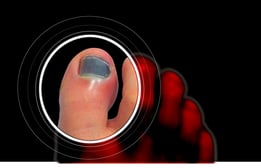Risks of Infection from Toenail Trauma And When Its Time To See A Specialist
 A bacterial toenail infection resulting from toenail trauma occurs because the injury has lacerated the nail bed underneath the nail plate and exposed the nail bed tissue to bacterial contamination.
A bacterial toenail infection resulting from toenail trauma occurs because the injury has lacerated the nail bed underneath the nail plate and exposed the nail bed tissue to bacterial contamination.
If there is an associated bone fracture with blunt force trauma to the toenail you may also be at risk for osteomyelitis (bone infection).
Trauma to the toenail can occur from an unexpected injury; stubbing it with great force, crushing it with something heavy or from a puncture wound. It can also occur from chronic or persistent repetitive motion pressure on the toenail, from a hammer toe or claw toe deformity that is aggravated by weight bearing or from footwear constantly rubbing against the toenail during physical activity.
Signs and Symptoms of Toenail Trauma Infection
- A noticeable subungual hematoma, blood trapped beneath the toenail
- Severe toenail pain, swelling and redness of the toe
- Yellow, green, brown, white or red discharge from beneath the toenail
- A raised nail unit
- Nail thickening
- Nail avulsion, the entire nail or a portion of the nail becomes loose and falls off
- Nail dystrophy, a splitting of the nail or decrease in size
Treatment for Pain From Toenail Trauma
When 25% or greater of the nail plate has blood under it the chances of a subungual laceration and or a bone fracture are high. In this case you should seek urgent medical care to avoid tissue and bone bacterial infection.
If the nail itself is still intact, and there is injury to the nail bed beneath, subungual pressure from the nail bed hemorrhage can cause persistent toe pain that may last several hours or several days. Only drainage of the hematoma will usually provide relief and this can only be safely done with sterile technique to ensure bacteria is not introduced into the fresh wound or bloodstream.
Typically when at least 25% of the nail is discolored from subungual hematoma the physician will remove the nail and inspect the nail bed. The nail bed will be flushed out, cleaned and the laceration repaired. X-rays will be taken to determine if there is a bone fracture. Usually exposed bone or bone fracture is repaired in the surgical setting with local anesthesia.
Medical Complications From Untreated Infection Due To Toenail Trauma
While injuries to the nail bed and the tip of the toe are common in the foot and the majority of these injuries are easily treated with successful outcomes, when suspected lacerations are not treated urgently and signs of infection ignored, more serious medical conditions can result.
Left untreated, bacterial infections of the soft tissue can infect the underlying bone. Once a bacterial infection reaches the bone, or enters the bloodstream, a course of IV antibiotics will be needed to successfully treat it. When the infection is severe enough, or has reached an advanced stage, a partial digital amputation may be necessary to keep the infection from spreading to other parts of the body.
Of you are experiencing any of the symptoms listed above after an injury to your toenail seek care from a medical specialist for a correct diagnosis and effective treatment as soon as possible.


